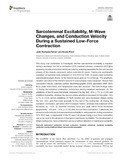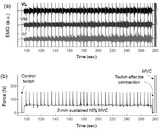Mostrar el registro sencillo del ítem
Sarcolemmal excitability, M-Wave changes, and conduction velocity during a sustained low-force contraction
| dc.creator | Rodríguez Falces, Javier | es_ES |
| dc.creator | Place, Nicolas | es_ES |
| dc.date.accessioned | 2022-04-12T06:27:08Z | |
| dc.date.available | 2022-04-12T06:27:08Z | |
| dc.date.issued | 2021 | |
| dc.identifier.issn | 1664-042X | |
| dc.identifier.uri | https://hdl.handle.net/2454/42718 | |
| dc.description.abstract | This study was undertaken to investigate whether sarcolemmal excitability is impaired during a sustained low-force contraction [10% maximal voluntary contraction (MVC)] by assessing muscle conduction velocity and also by analyzing separately the first and second phases of the muscle compound action potential (M wave). Twenty-one participants sustained an isometric knee extension of 10% MVC for 3min. M waves were evoked by supramaximal single shocks to the femoral nerve given at 10-s intervals. The amplitude, duration, and area of the first and second M-wave phases were computed. Muscle fiber conduction velocity, voluntary surface electromyographic (EMG), perceived effort, MVC force, peak twitch force, and temperature were also recorded. The main findings were: (1) during the sustained contraction, conduction velocity remained unchanged. (2) The amplitude of the M-wave first phase decreased for the first ~30s (−7%, p<0.05) and stabilized thereafter, whereas the second phase amplitude increased for the initial ~30s (+7%, p<0.05), before stabilizing. (3) Both duration and area decreased steeply during the first ~30s, and then more gradually for the rest of the contraction. (4) During the sustained contraction, perceived effort increased fivefold, whereas knee extension EMG increased by ~10%. (5) Maximal voluntary force and peak twitch force decreased (respectively, −9% and −10%, p<0.05) after the low-force contraction. Collectively, the present results indicate that sarcolemmal excitability is well preserved during a sustained 10% MVC task. A depression of the M-wave first phase during a low-force contraction can occur even in the absence of changes in membrane excitability. The development of fatigue during a low-force contraction can occur without alteration of membrane excitability. | en |
| dc.description.sponsorship | This work has been supported by the Spanish Ministry of Science and Innovation under the project PID2019-109062RB-I00. | en |
| dc.format.extent | 13 p. | |
| dc.format.mimetype | application/pdf | en |
| dc.format.mimetype | image/tiff | en |
| dc.language.iso | eng | en |
| dc.publisher | Frontiers Media | en |
| dc.relation.ispartof | Frontiers in Physiology, 12, 2021 | en |
| dc.rights | © 2021 Rodriguez-Falces and Place. Creative Commons Attribution 4.0 International | en |
| dc.rights.uri | http://creativecommons.org/licenses/by/4.0/ | |
| dc.subject | Conduction velocity | en |
| dc.subject | Low-level contraction | en |
| dc.subject | Membrane excitability | en |
| dc.subject | Neuromuscular propagation | en |
| dc.subject | Peripheral fatigue | en |
| dc.subject | Submaximal contraction | en |
| dc.subject | Sustained contraction | en |
| dc.title | Sarcolemmal excitability, M-Wave changes, and conduction velocity during a sustained low-force contraction | en |
| dc.type | Artículo / Artikulua | es |
| dc.type | info:eu-repo/semantics/article | en |
| dc.contributor.department | Ingeniería Eléctrica, Electrónica y de Comunicación | es_ES |
| dc.contributor.department | Ingeniaritza Elektrikoa, Elektronikoa eta Telekomunikazio Ingeniaritza | eu |
| dc.rights.accessRights | info:eu-repo/semantics/openAccess | en |
| dc.rights.accessRights | Acceso abierto / Sarbide irekia | es |
| dc.identifier.doi | 10.3389/fphys.2021.732624 | |
| dc.relation.projectID | info:eu-repo/grantAgreement/AEI/Plan Estatal de Investigación Científica y Técnica y de Innovación 2017-2020/PID2019-109062RB-I00/ES/ | en |
| dc.relation.publisherversion | https://doi.org/10.3389/fphys.2021.732624 | |
| dc.type.version | info:eu-repo/semantics/publishedVersion | en |
| dc.type.version | Versión publicada / Argitaratu den bertsioa | es |




